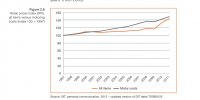Sure... of course it's more complex than a blunt comparison of numbers can really show.
The general point was though - does somewhere like London
(relatively central london if we're talking about the S circular) need road capacity to be increased or should we instead be persuading people away from private cars, and making better use of the existing capacity? I'd say the latter. I said other cities manage to do better than London and then I was challenged on that.
This report:
gives private transport mode share of 46-50% in outer London and 21-27% in inner London.
So, let's take 21% for inner London and ask, is it feasible to reduce that further? I can point to Paris at 16% and Tokyo at 12% and say yes.
The fact that private transport mode share is pretty strongly correlated with density is, in itself, an indeication that if you want to make best use of limited space, you need to reduce the number of trips made by private transport. Places like Tokyo still function perfectly well with that very low percentage of journeys being made by private car. Stuff still gets delivered to the jobs and people still get to work. Having stayed there for a bit, I can confirm that it makes the residential areas much, much more pleasant (as far as street congestion is concerned) than the norm in British cities, including London.




